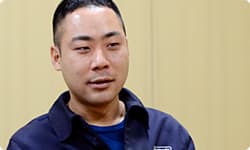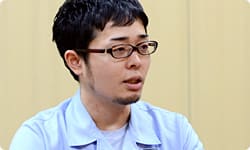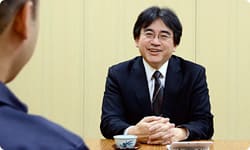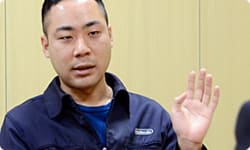Mario Cram School
Today, I would like to ask about the New Super Mario Bros. 2 game, soon to be released for the Nintendo 3DS system. Please introduce yourselves, including what you were in charge of for this game.
I'm Amano. I was the director. I also participated in the sessions of "Iwata Asks" over the 25th anniversary of Super Mario Bros.1 and Star Fox 64 3D.2, so this is my third time.
That's right.
This time again, as if something were guiding me, I got put in charge of Super Mario! (laughs) It's a pleasure to be here today.
1. Super Mario Bros. 25th Anniversary: A campaign carried out in 2010 to mark 25 years since Super Mario Bros. was released for the NES system.
2. Star Fox 64 3D: A shooting game released for the Nintendo 3DS system in July 2011.
I'm Ishikawa from the Software Development Department. I was in "Iwata Asks" to discuss Mario Kart 73 a bit back, and was involved with New Super Mario Bros. Wii4 before that. As art director on New Super Mario Bros. 2, I was in charge of a number of things, pulling together the overall visuals such as design and direction surrounding the player-character.
3. Mario Kart 7: An action-racing game released for the Nintendo 3DS system in December 2011.
4. New Super Mario Bros. Wii: An action game released for the Wii console on December 3, 2009.
Okay. First of all, I'd like to ask how this project started. Now normally when people imagine how video games are made, you'd think that it starts off by building its base mechanics, and then work on designing the courses. But I heard this game's start was a little different.
Yes, that's right. This time the team that researches course design started working on developing the courses first, and the other staff were called in to turn it into an actual product. This format was a first for me.
When you say the team that researches course development, you're talking about what is called the Mario Cram School.
Yeah. The Software Development Department of the Entertainment Analysis & Development Division (EAD) has always made the classic side-scrolling Super Mario games, but this time, there was an opportunity where (Takashi) Tezuka-san5 gathered people not only from EAD, but also from the Software Planning & Development Department, and from other departments to explain how to make Super Mario stages. I was also involved with it as one of the students. 5. Takashi Tezuka: General Manager, Software Development Department, Entertainment Analysis & Development Division. He has been involved in the development of many series such as Super Mario, Yoshi and Animal Crossing. He appeared in the session of Iwata Asks for the Super Mario Bros. 25th Anniversary called "Original Super Mario Bros."
Why did the Mario Cram School begin?
I heard Tezuka-san believes that the course design plays a key role in determining the fundamental elements of 2D Mario games, so he opened the cram school in hopes to spread that knowledge across others within the company. Alongside Tezuka-san, (Toshihiko) Nakago-san6 was also deeply involved with this project. 6. Toshihiko Nakago: President of SRD Co., Ltd. Beginning with Super Mario Bros., he has been involved in the development of numerous titles for Nintendo since the dawn of the NES. He is serving as adviser for New Super Mario Bros. 2. He has appeared in the session of "Iwata Asks" for the Super Mario Bros. 25th anniversary called "Original Super Mario Developers."
You said you participated in it. How was it like?
Yeah I did participate in the cram school, but that was around the time when we were working on Starfox 64 3D, so I wasn't able to participate with full force. But as someone who worked on New Super Mario Bros. Wii, I had the opportunity to try out a course made in the Mario Cram School that was worked on by about twice the number of staff it usually takes to make Mario courses. A lot of the courses were a blast to play and showed a lot of new ways to play, I really felt we were on to something. Looking at it from that perspective, I thought the concept of the Mario Cram School was amazing.
You looked at it from the corner of your eye as if it were someone else's concern. (laughs)
Yes. (laughs) That was what I was thinking, but Tezuka-san suddenly asked me if I would like to be the director for the next Super Mario game for the 3DS. I was like, "Uh…that's why they had me play those courses…" (laughs)
You thought you weren't involved at all, and all the sudden you became the person who would be most involved with the project! (laughs)
That's not all. This time the Mario game for Wii U7is being developed at an almost simultaneous timing, so we had to get two 2D Mario games ready for release. 7. New Super Mario Bros. U: An action game under development for the Wii U console.
While the hardware for these 2D Super Mario games is different, you must think about how you can make each game distinctive. Amano-san, did they just dump that on you?
Not really, Tezuka-san and (Toshihiko) Nakago-san worked together with me from the start of the Mario Cram School, so for me it was like we were working together, rather than me taking it on by myself. They both thought it would work out somehow.
"Somehow"? (laughs)
Yeah. And at the start when I was appointed director, we didn't have any designers.
Nintendo does the most awful things! (laughs)
Yeah! (laughs) I was like, "What am I gonna do?!"
Tezuka-san and Nakago-san were like, "It'll work out somehow," but you were like, "What am I gonna do?!"
Yes.
Ishikawa-san, you came in later on as art director.
Yes, that's right.
But until the latter half of 2011, you were absorbed in Mario Kart 7, right?
Yes. And a little before Mario Kart 7, there was Super Mario 3D Land8, which was close to a traditional Super Mario game in that it was made in a classic direction, so I thought, "Whoever's in charge of the next 2D Super Mario game will have a real hard time!" (laughs)
Yet another person who thought it had nothing to do with him! (laughs) 8. Super Mario 3D Land: A 3D action game released for the Nintendo 3DS system in November 2011.
Soon after development of Mario Kart 7 ended, I was asked if I'd do it, and I was floored, like, "What?!"
I'm sure you were. Because until that time you were thinking of it as somebody else's business, and all the sudden you were the one who had to do something about it.
But already at that time, it was decided that two designers from our Tokyo Software Development Department would soon join the team, and later on, a few more designers joined the project who had been involved in Mario Kart 7.
The project gained one member after the other who had experience developing actual games for the Nintendo 3DS.
Yes. I thought, "Now we should be able to make something fun!" and began to really look forward to it.
But Ishikawa-san and I were the only two core members of this project who had some sort of experience working on 2D Super Mario games.
Developers with experience in 2D Super Mario are working on Super Mario for the Wii U right now. It was an unprecedented approach, even though Tezuka-san and Nakago-san were both working very closely to the development team, more than they ever had on a 2D Mario game, from the time they took the podium at Mario Cram School to the actual development phases of this project.
Yeah. A few people from the Software Planning & Development Department, in addition to their design staff, also joined.
I believe quite a number of unique individuals with great dynamic range in term of capabilities came to participate from the Software Planning & Development Department.
Yes. Some knew a lot about games and some didn't, but the Mario Cram School we mentioned earlier came in incredibly useful. Participants got a firm grasp of the basic ingredients of what makes 2D Super Mario enjoyable and experienced actually making stages, so we were able to begin this project with a solid foundation.
In that respect, some new blood came in to those in charge of stage construction theory and actually making the stages.
Yes, so I expected that we would be able to make something new that the teams so far hadn't.
In addition, forming such a team made it possible to achieve what we never had before—making two New Super Mario Bros. games at once!




